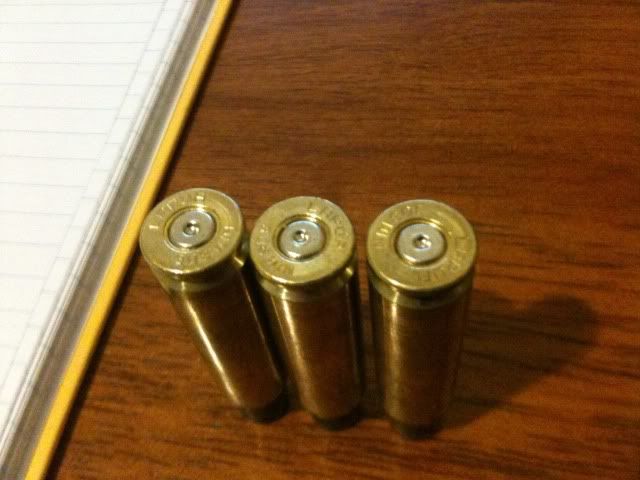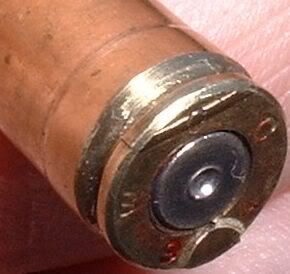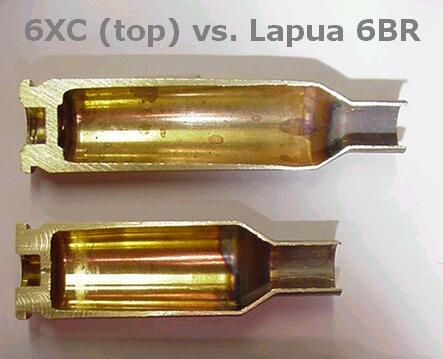Re: .308 high pressure?
Quickload think that 168 gr SMK 2.8" OAL, Ramshot TAC, 24" barrel is:
a) 43.5 gr 58 kpsi 2681 fps
b) 44.5 gr 58 kpsi 2736 fps
c) 48.4 gr 76 kpsi 2942 fps
-------------------------------
Scott Sweet has calculated and divulged to me the failure mode and pressure for the following case heads; Mauser, H&H magnum, Rem Ultra Mag, 460 Weatherby, Rigby, 7.62x39 small Boxer, 7.62x39 large Boxer, and .222 Rem.
I have only verified consistency with Quickload in 223 and Mauser case heads.
Scott calculated von Misses stress in the 1889 7.65x53mm Mauser case head when built with a large Boxer primer [.308Win, 30-06, 243, etc] fails with a loose primer pocket at 77 kpsi +/- 7%.
-----------------
Per my experimental overloads I find that the 1889 7.65x53mm Mauser case head when built with a large Boxer primer [.308Win] fails with a loose primer pocket at 75 kpsi +/- 3.5% QL with with IMR4895, H335, and Varget. I have not validated the Quickload library constants for TAC.
I find that measuring any changes around the extractor groove is a better pressure indicator and precursor for loose primer pocket than either waiting for the primer to fall out or measuring the primer pocket with pin gauges.
That is because the spent primers can stay in there like hanging chads, and the expansion is often not symmetrical. The non symmetrical expansion can be found by turning the calipers relative to the outside diameter of the extractor groove, but round pin gauges are blocked if any part of the primer pocket maintains the original diameter. When I developed this system, ~ 5 years ago, it was suggested that I find "D" shaped pin gauges, but I have not done that.
--------------------------
Here is an example of my tests:
Hodgdon max book load:
308 WINCHESTER, CASE: WINCHESTER, BBL: 24", PR: FEDERAL 210M, 168 GR. SIE HPBT COL: 2.800" H335, 42.0 gr., 2631 fps, 49,300 CUP
My test:
Pacific .308 Win reamer, VZ24 trued action, A&B fluted stainless 24" F54 barrel, H335, CCI200 primer, 2.9" OAL, Speer 168 gr. HPBT Gold Match, brass: Win308Win:
1- 10 order left through right
0) 42 gr. QL= 2565 fps & 46 kpsi, 0% overload, did not load 42 gr.
1) 43 gr. QL= 2618 fps & 49 kpsi, 2% overload, ok
2) 44 gr. QL= 2670 fps & 52 kpsi, 5% overload, cratered primer this and higher
3) 45 gr. QL= 2722 fps & 56 kpsi, 7% overload
4) 46 gr. QL= 2774 fps & 60 kpsi, 10% overload
5) 47 gr. QL= 2825 fps & 64 kpsi, 12% overload
6) 48 gr. QL= 2875 fps & 68 kpsi, 14% overload, mark on brass from bolt face extractor this and higher,
7) 49 gr. QL= 2925 fps & 73 kpsi, 17% overload
8) 50 gr. QL= 2974 fps & 78 kpsi, 19% overload, extractor cut on brass expands .0020"
9) 51 gr. QL= 3024 fps & 84 kpsi, 21% overload, extractor cut on brass expands .0020"
10) 52 gr. QL= 3073 fps & 90 kpsi, 24% overload, extractor cut on brass expands .0110", primer fell out,
------------------------------
What does it all mean?
a) Expect short brass life at 75 kpsi ~ 77 kpsi with that case head.
b) Yes, you have high velocity.






